In today’s fast-moving digital world, advertising has grown beyond just reaching the most people; rather, it has transformed into reaching the right audience at the right place and time.
That’s where location-based ads play their part.
As location tracking technologies continue to grow more accurate and mobile devices continue to rise in popularity, businesses have an unprecedented opportunity to target their audiences better than ever.
Whether you’re a small business owner or a large enterprise, understanding and leveraging location-based advertising can help you optimize your marketing campaigns and achieve measurable results.
In this article, we’ll explore five key strategies to help you maximize the potential of location-based advertising.
Let’s start by understanding the basics of what makes location-based ads so powerful.
- Understanding Location-Based Advertising
- Setting Up Location Targeting in Google Ads
- Best Practices for Effective Location-Based Campaigns
- Measuring Success: Key Metrics for Location-Based Ads
- Overcoming Challenges in Location-Based Advertising
- Maximizing the Impact of Location-Based Advertising
- Frequently Asked Questions About Location-Based Advertising
Understanding Location-Based Advertising
Location-based advertising is a digital marketing strategy that leverages a user’s geographic location to deliver highly targeted and relevant ads.
By using technologies like GPS, Wi-FiA wireless networking technology that allows devices to connect to the internet without physical cables., or IP addressesUnique numerical labels assigned to devices connected to a computer network for identification., marketers can identify where their target audience is and tailor their messaging accordingly.
This approach not only improves the effectiveness of your ads but also enhances the user experience by providing contextually relevant content.

Visual depiction of the definition and importance of location-based advertising.
Definition and Importance
At its core, location-based advertising allows for the delivery of ads to users based on their current or past location.
For example, a coffee shop might display its advertisements to users who are within a one-mile radius during morning hours to entice them into coming for their daily caffeine fix.
This strategy is important for reaching out with personalized and meaningful interactions to potential customers, increasing the chances of engagement and conversion.

Visual representation of how location data drives precise and effective ad targeting.
How Location Data Enhances Ad Targeting
Location data is a goldmine for marketers.
It tells you where your audience spends their time, which places they visit, and even their shopping habits.
By analyzing this information, businesses can:
- Deliver ads at the right time when users are most likely to take action.
- Target specific geographic areas to reach local audiences effectively.
- Understand customer preferences and behavior patterns.
This level of precision ensures that your ad spend is used efficiently, focusing on users who are more likely to respond to your campaigns.

Illustration of various types of location-based advertising techniques.
Types of Location-Based Advertising
There are several types of location-based advertising, each suited to different marketing goals:
- Geotargeting: Targeting users within a specific geographic area.
- Geofencing: Drawing a virtual boundary around an area and triggering ads when users enter or leave the boundary.
- Proximity Marketing: Using Bluetooth or Wi-Fi to reach users around a point of interest.
- Behavioral Targeting: Showing ads according to the past location history and behavior of users.
Each type has its unique benefits, and the best choice depends on your business objectives and audience.
Location-based advertising utilizes geographic data to deliver highly relevant and targeted ads, increasing engagement and effectiveness.
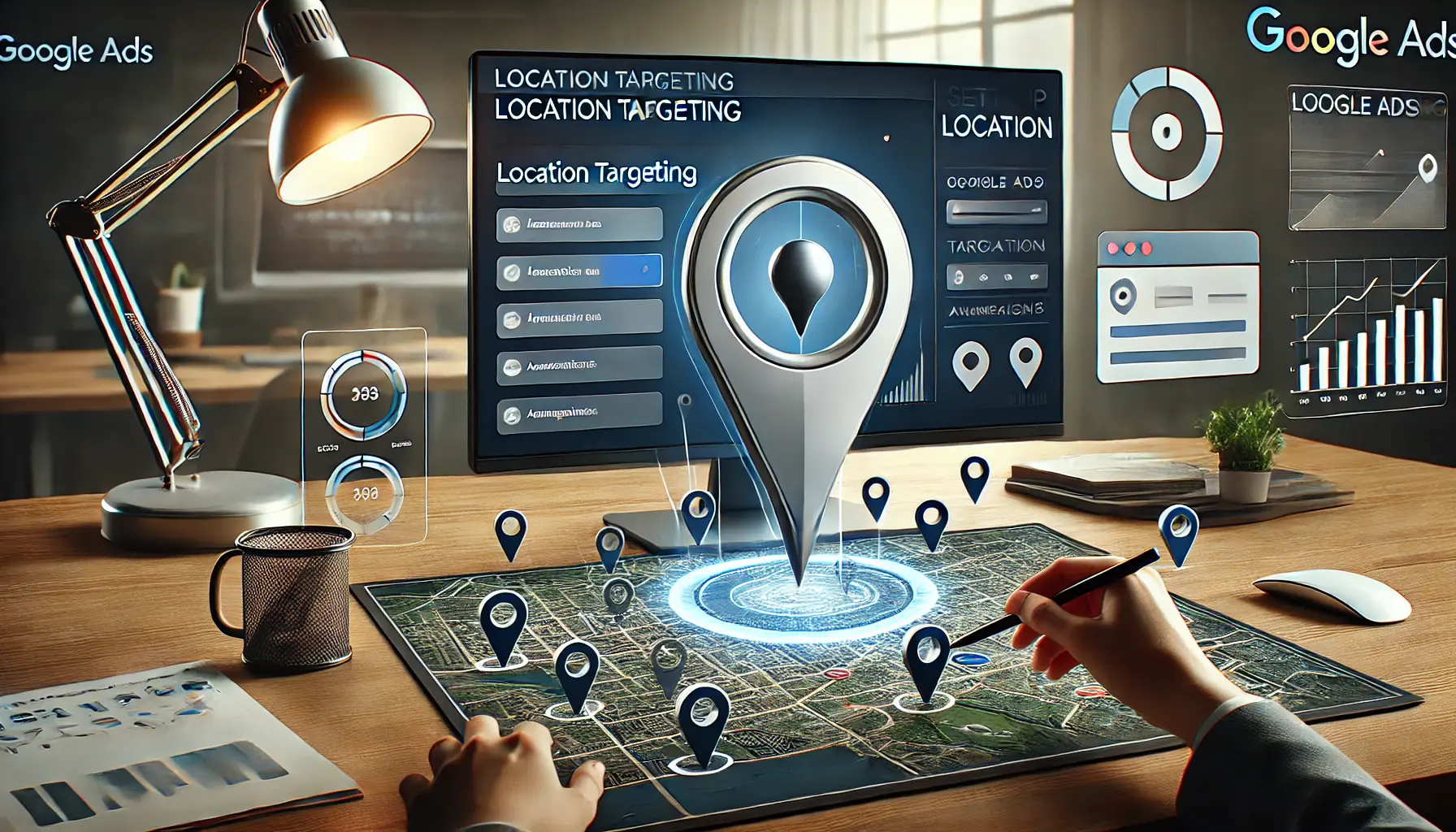
Visualization of configuring location targeting within the Google Ads platform.
Setting Up Location Targeting in Google Ads
Implementing location-based advertising in your marketing strategy requires a precise setup within Google Ads.
This ensures your ads reach the intended audience in specific geographic areas, enhancing relevance and effectiveness.

Illustration of accessing location settings within a digital advertising platform.
Accessing Location Settings
First, log into your Google Ads account and go to the campaign you want to edit or create a new one.
From the left-hand menu, click on “Settings”, then select “Locations”.
From this screen, you can define precisely where, geographically, your ads will appear.

Visual representation of selecting geographic areas for targeted advertising.
Choosing Geographic Areas to Target
Google Ads offers several options for defining your target locations:
- Countries: Target full countries to appeal to a wide audience.
- Regions or States: Narrow down to particular states or regions within a country.
- Cities: Target specific cities in which your future customers will be living.
- Postal Codes: Effectively target specific postal codes for the most localized advertising.
- Radius Targeting: Set a radius around any given location to show ads to users within a specific distance from that point.
For instance, if your business operates in Adana, Türkiye, you might choose to target users within a 10-kilometer radius of your store to attract local customers.

Illustration of excluding specific locations in a digital advertising platform.
Excluding Specific Locations
In some cases, you may want to exclude certain areas from your targeting to prevent your ads from showing in locations where your services are unavailable or irrelevant.
To do this, go to the “Locations” section, click on “Advanced Search”, and select the areas you wish to exclude.
This ensures your ad spend is utilized efficiently by focusing only on relevant regions.

Visual representation of radius targeting in a digital advertising platform.
Utilizing Radius Targeting
Radius targeting, also referred to as proximity targeting, enables you to serve ads to users within a certain distance from a location.
To complete this, follow these steps:
- In the “Locations” section, click on “Advanced Search”.
- Click on the “Radius” option.
- Enter your business address or any pivotal address.
- Type in the radius distance in kilometers, such as 5 kilometers.
- Click “Save”.
This is particularly useful for businesses where proximity to customers is important, such as restaurants, retail shops, or service providers.
While setting this up might take some time, it ensures your ads are shown in the most relevant locations and yields the best return on investment for your location-based advertising efforts.
Using radius targeting in Google Ads ensures your ads are displayed to users most likely to engage with your business based on their proximity.

Illustration of best practices for optimizing location-based campaigns.
Best Practices for Effective Location-Based Campaigns
Implementing location-based advertising can significantly enhance your marketing efforts.
To maximize its effectiveness, consider the following best practices:

undefined
Aligning Ads with Local Consumer Behavior
Understanding the preferences and behaviors of your local audience is crucial.
Tailor your ads to resonate with the local culture, events, and trends.
For instance, if you’re advertising in Adana, Türkiye, incorporating local festivals or popular landmarks into your ad content can make your message more relatable and engaging.

Visualization of incorporating local keywords into ad copy for targeted campaigns.
Incorporating Local Keywords in Ad Copy
Enhance the visibility of your ads by including local keywords.
This strategy improves your ad’s relevance to users searching for services in specific areas.
For example, using phrases like “best coffee shop in Adana” can attract users looking for local options.
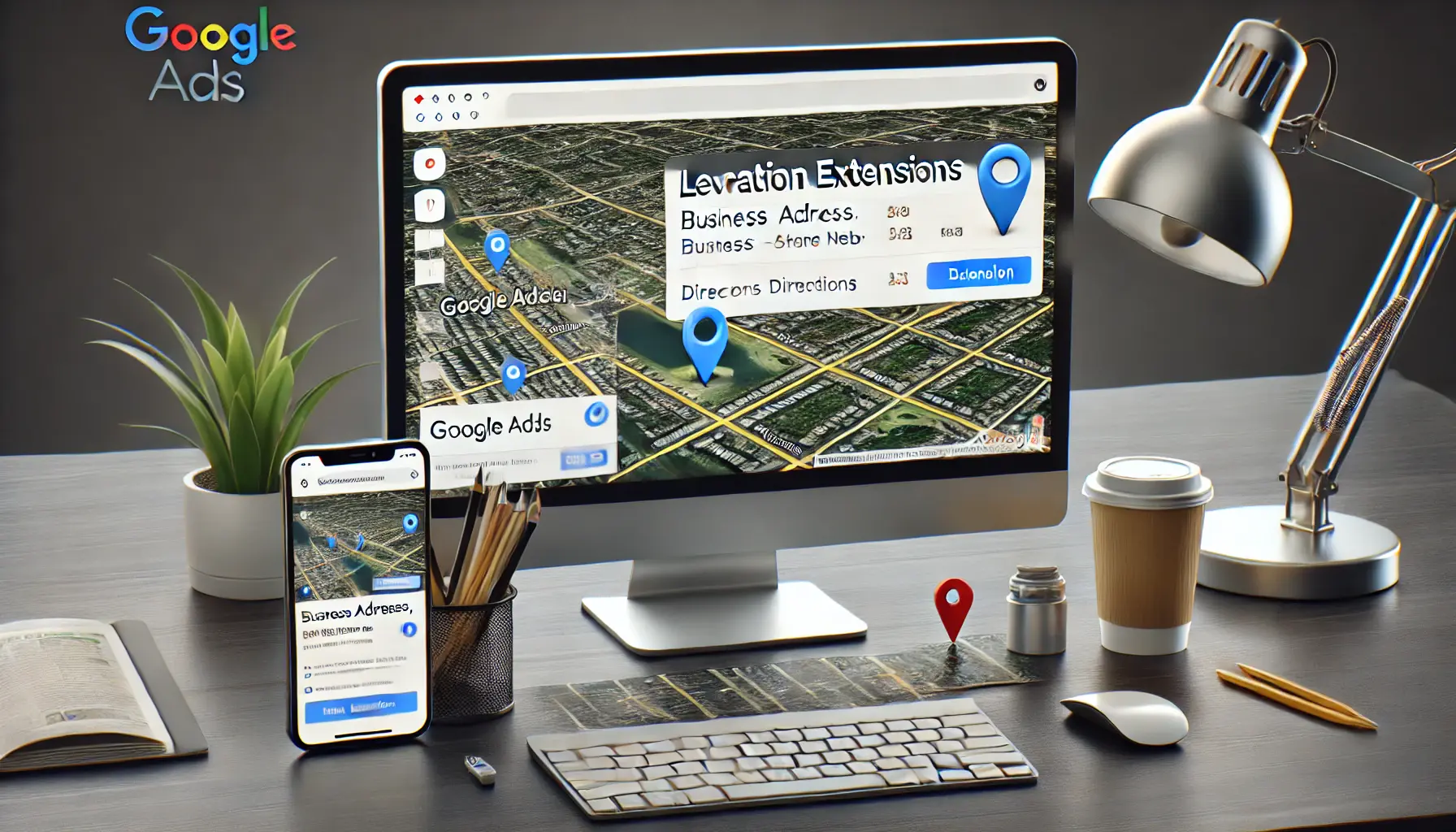
Illustration of leveraging location extensions in digital advertising.
Leveraging Location Extensions
Utilize location extensions in your ads to provide potential customers with your business address, phone number, and directions.
This feature makes it easier for users to find and contact you, increasing the likelihood of in-store visits.
According to Google, ads with location extensions can see a 10% increase in click-through rates.

Visual representation of adjusting bids based on location performance in digital advertising.
Monitoring and Adjusting Bids Based on Location Performance
Periodically check the performance of your ads in different locations.
Identify regions that are performing well and increase bids in those areas to maximize your ad’s display.
Conversely, decrease bids or exclude underperforming locations.
This ensures the proper utilization of your advertising budget and optimizes campaign performance.
By following these best practices, you can ensure that your location-based advertising campaigns are not only effective but also efficient for reaching your target audience.
Incorporating local keywords and aligning ads with regional behavior significantly boosts the success of location-based campaigns.

Illustration of measuring success with key metrics for location-based ads.
Measuring Success: Key Metrics for Location-Based Ads
To ensure the effectiveness of your location-based advertising campaigns, it’s essential to monitor specific performance metrics.
By analyzing these key indicators, you can refine your strategies and maximize return on investment (ROI).
Illustration of tracking location-specific click-through rates for location-based advertising.
Tracking Location-Specific Click-Through Rates (CTR)
Click-Through Rate (CTR) measures the percentage of users who click on your ad after viewing it.
Monitoring CTR across different locations helps identify areas where your ads resonate most with the audience.
A higher CTR in a particular region indicates effective targeting and compelling ad content.

Visual representation of analyzing conversion rates by region for location-based advertising.
Analyzing Conversion Rates by Region
Conversion rate is defined as the percentage of users who complete a desired action, such as making a purchase or signing up for a newsletter, after clicking on your ad.
Analyzing conversion rates across different regions provides insights into how well your ads drive user actions in specific areas.
This information allows you to allocate resources to high-performing regions and adjust strategies in underperforming ones.

Visualization of measuring return on investment (ROI) for geotargeting campaigns.
Measuring Return on Investment (ROI) of Geotargeting Campaigns
To calculate ROI, compare the revenue generated from your advertisements against the cost of running them.
For location-based advertising, it is critical to calculate ROI on a regional level.
This analysis reveals which regions yield better financial returns, helping you allocate your budget to more profitable areas.
Illustration of tracking foot traffic and in-store visits from location-based ads.
Tracking Foot Traffic and In-Store Visits
For businesses with physical locations, tracking foot traffic resulting from your ads is vital.
Utilize tools like Google Analytics and store visit data to measure the number of users who visit your store after interacting with your ad.
This metric provides a direct link between your digital advertising efforts and offline customer engagement.
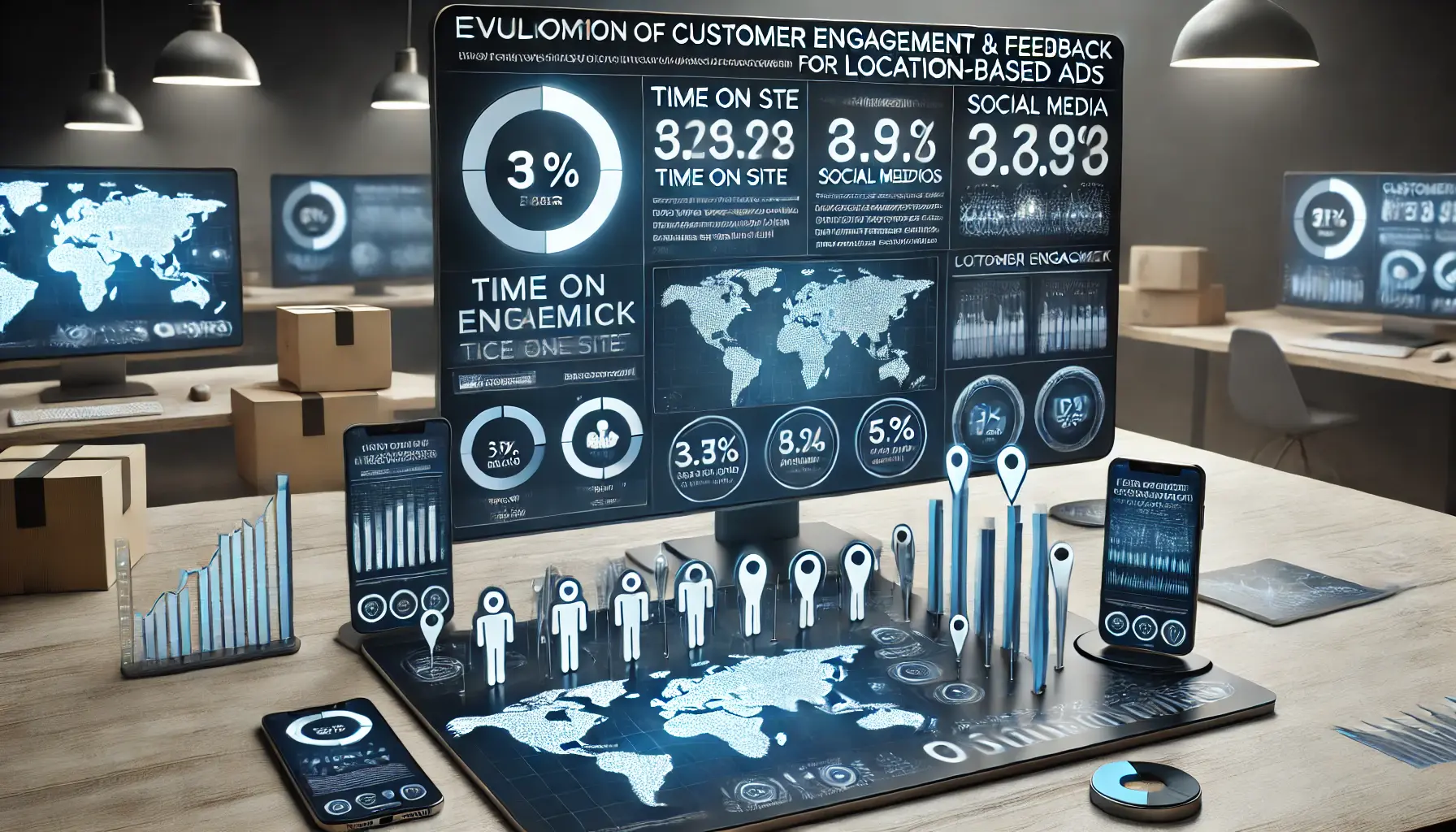
Illustration of evaluating customer engagement and feedback for location-based ads.
Evaluating Customer Engagement and Feedback
Engagement metrics such as time on site, pages viewed, and social media interactions indicate how users engage with your brand after viewing an ad.
Additionally, collecting customer feedback through surveys or reviews serves as qualitative data to assess the effectiveness of your location-based advertising strategies.
By diligently monitoring these metrics, you can make informed decisions to optimize your location-based advertising campaigns, ensuring they effectively reach and engage your target audience.
Analyzing key metrics like CTR, conversion rates, and ROI at a regional level helps refine your campaigns for better performance.

Illustration of overcoming challenges in location-based advertising.
Overcoming Challenges in Location-Based Advertising
While location-based advertising offers significant advantages, it also presents certain challenges.
Addressing these effectively is crucial for the success of your campaigns.

Illustration of ensuring data accuracy and precision in location-based advertising.
Ensuring Data Accuracy and Precision
Accurate location data is the cornerstone of effective location-based advertising.
Inaccurate data can lead to misdirected ads, wasting resources and potentially frustrating users.
To enhance data accuracy:
- Utilize Reliable Data Sources: Partner with reputable data providers to ensure the information guiding your campaigns is precise.
- Regularly Update Data: Keep your location data current to reflect changes in user behavior and demographics.
- Implement Data Validation Processes: Establish protocols to verify the accuracy of collected data before using it in your campaigns.

undefined
Addressing Privacy Concerns and Compliance
Location-based advertising is extremely sensitive to privacy.
Users are increasingly aware of how their data is collected and used.
To address this:
- Obtain Explicit Consent: Be transparent with users and ensure they agree to share their location data.
- Adhere to Regulations: Comply with data protection laws such as the General Data Protection Regulation (GDPR) and the California Consumer Privacy Act (CCPA).
- Apply Data Masking: Use methods to anonymize user data, protecting individual identities while still deriving valuable insights.
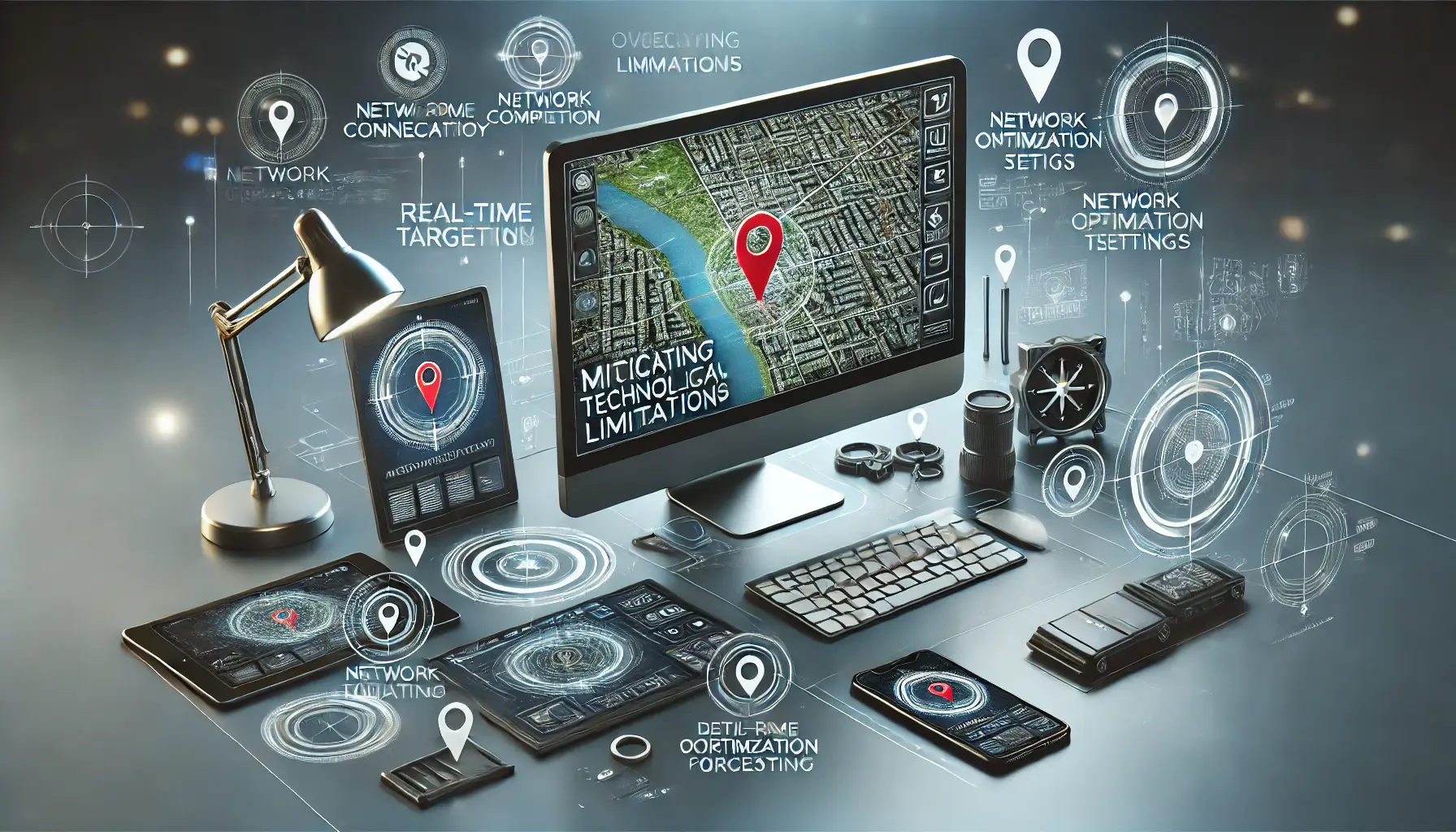
undefined
Mitigating Technological Limitations
Technological limitations can affect the efficiency of location-based advertising.
To overcome these challenges:
- Ensure Compatibility Across Devices: Make sure your ads are accessible across multiple devices and platforms.
- Make Use of Advanced Targeting Tools: Leverage tools offering granular geofencing and real-time data analysis.
- Monitor Performance Metrics: Regularly assess campaign performance to identify and address technological issues promptly.

Illustration of combating ad fatigue and overexposure in digital advertising.
Combating Ad Fatigue and Overexposure
Repeated exposure to the same ads can lead to ad fatigue, reducing their effectiveness.
To prevent this:
- Rotate Ad Creatives: Regularly update your ad content to keep it fresh and engaging.
- Set Frequency Caps: Limit the number of times a user sees your ad within a specific period.
- Content Personalization: Personalize ads based on user preferences and behaviors to maintain relevance.
By addressing these challenges proactively, you can make your location-based advertising campaigns even more effective in delivering value for your business and your audience.
Privacy concerns and data accuracy are critical challenges in location-based advertising that must be addressed with explicit consent and reliable data sources.
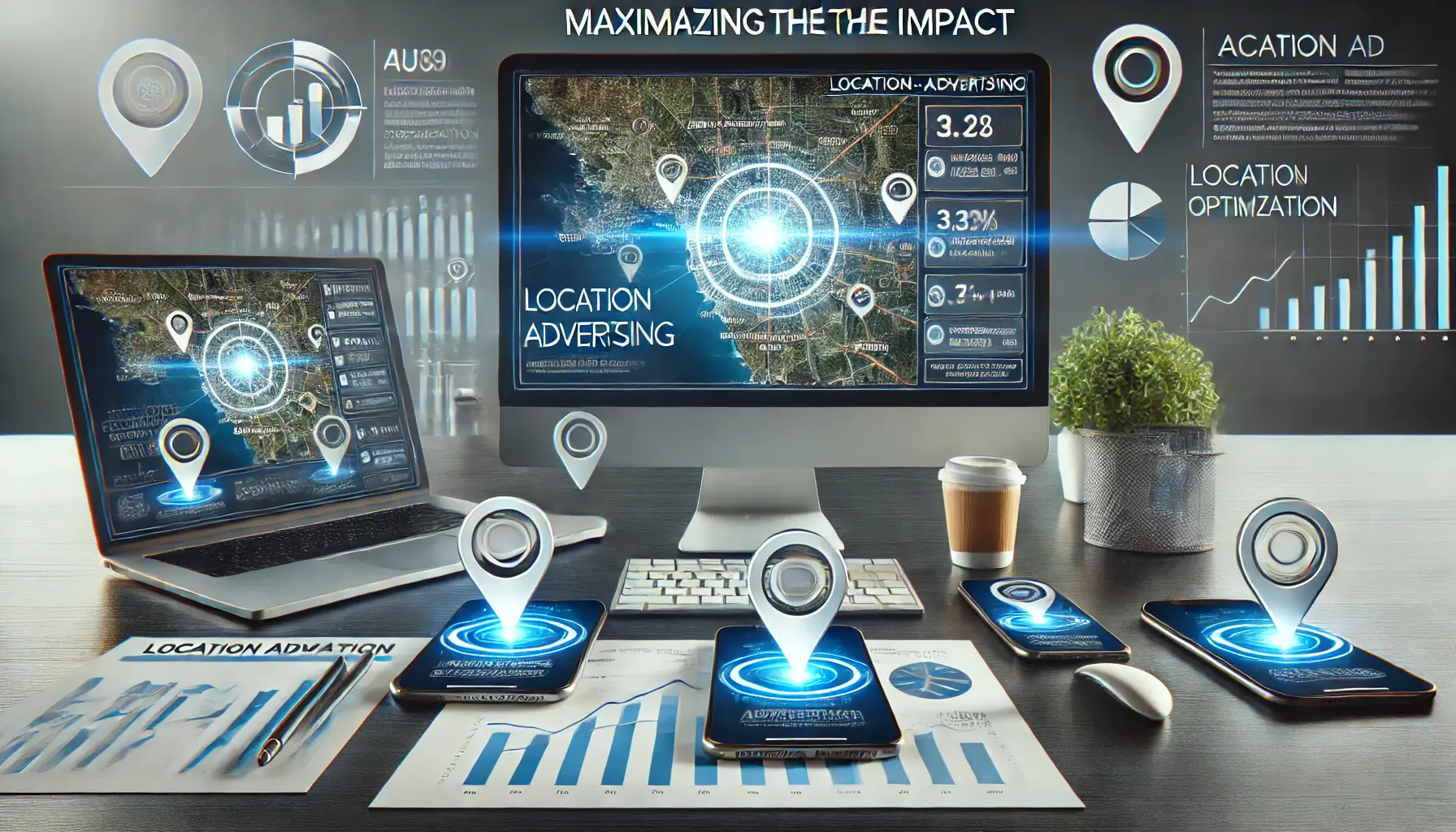
Illustration of maximizing the impact of location-based advertising.
Maximizing the Impact of Location-Based Advertising
Location-based advertising is a powerful tool that enables businesses to reach their target audience with precision and relevance.
By leveraging geographic data, businesses can craft personalized campaigns that resonate with local consumers and drive meaningful engagement.
To ensure success, it is essential to implement effective strategies and address potential challenges proactively.
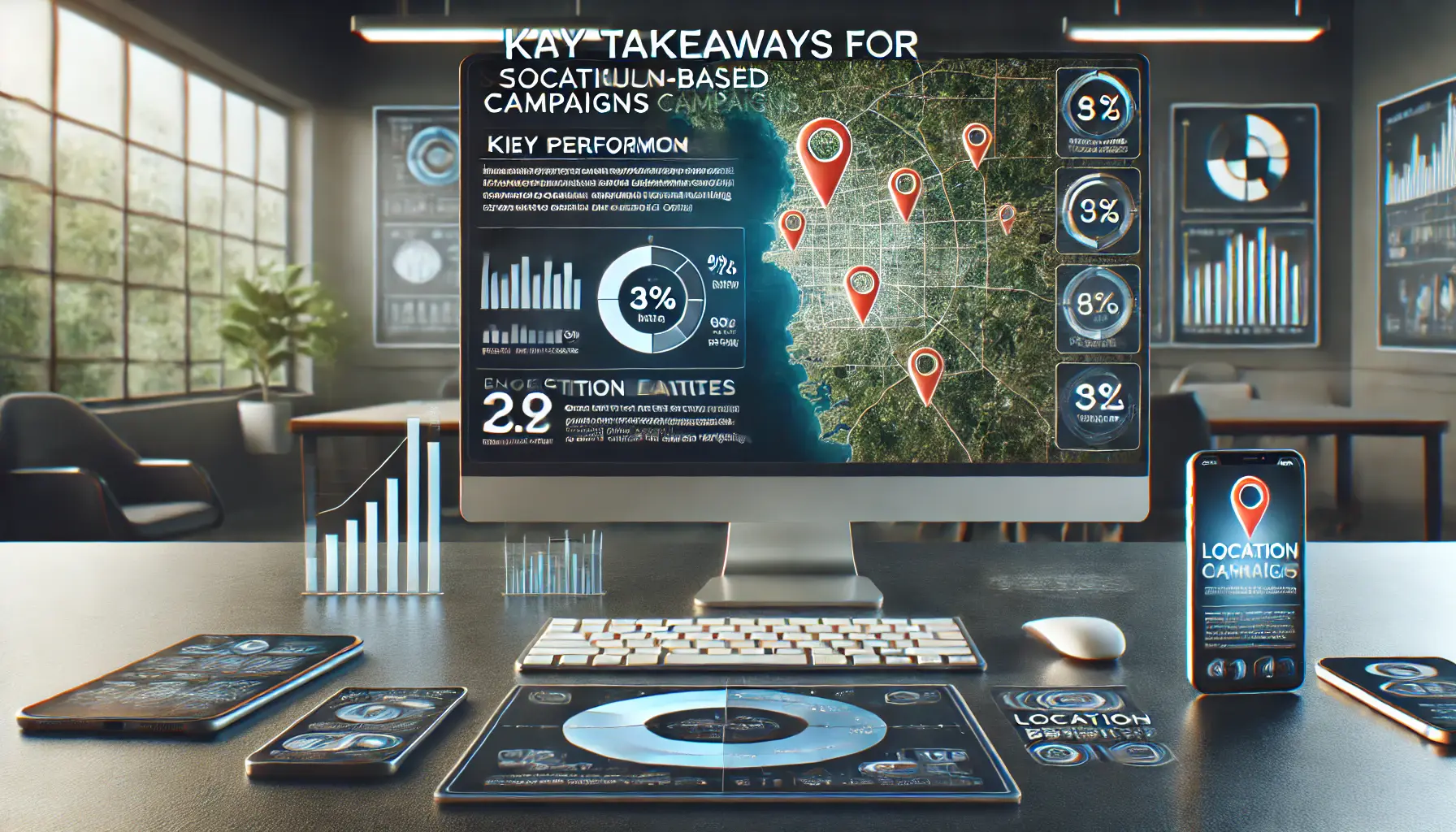
Illustration of key takeaways for successful location-based campaigns.
Key Takeaways for Successful Location-Based Campaigns
This article covered some critical aspects of creating and managing effective location-based advertising campaigns.
Key takeaways include:
- Know Your Audience: Understand the local behaviors of your audience and shape your campaigns to reflect cultural and regional nuances.
- Utilize Local Keywords: Use local keywords and add features like location extensions to increase ad relevance and visibility.
- Implement Precision Targeting: Leverage Google Ads location targeting, including radius targeting and excluding areas irrelevant to the business.
- Track Key Metrics: Monitor key metrics such as CTR, conversion rates, and ROI to measure campaign success and identify areas for improvement.
- Address Privacy Concerns: Follow regulations, request explicit user consent, and ensure the accuracy and security of stored data.

Illustration of overcoming obstacles and ensuring sustainability in location-based advertising.
Overcoming Obstacles: Ensuring Sustainability
While location-based advertising offers significant opportunities, it also comes with challenges such as ensuring data accuracy, addressing privacy issues, and combating ad fatigue.
By following best practices and utilizing advanced tools, businesses can overcome these obstacles and maintain campaign effectiveness.
Regular updates to ad creatives, frequency capping, and personalization are key to keeping campaigns engaging and relevant.

Illustration of ‘The Road Ahead’ in the future of location-based advertising.
The Road Ahead
As technology continues to advance, the potential of location-based advertising will only grow.
Businesses that adopt precise targeting strategies gain competitive advantages in their marketing efforts.
By leveraging the insights from this article, you can devise campaigns focused on achieving your business objectives while ensuring value delivery to your audience.
Ultimately, location-based advertising is about successfully connecting businesses with their audience in meaningful ways that inspire trust and build lasting customer relationships.
Take a step forward today in refining your strategies and unlocking the true potential of location-based advertising.
Regularly updating strategies and monitoring campaign performance ensures the long-term effectiveness of location-based advertising.

Illustration of frequently asked questions in location-based advertising.
Your campaigns can be managed by an agency specialized in Google Ads, check out our service page.
Frequently Asked Questions About Location-Based Advertising
Location-based advertising is a dynamic field with many nuances.
Below are some common questions and concise answers to help you understand its key aspects.
Location-based advertising refers to serving ads to users based on their current geographical location.
It utilizes technologies like GPS, Wi-Fi, or IP addresses to deliver relevant and timely content.
It uses location data from users’ devices to target ads, ensuring messages are contextually relevant to the user’s current or past locations, enhancing engagement and conversion rates.
Benefits include precision targeting, improved ROI, real-time engagement, and valuable data insights into consumer behavior, leading to more effective marketing strategies.
Technologies include GPS, Wi-Fi, Bluetooth beacons, and IP address targeting, all of which help determine a user’s location for delivering relevant ads.
Yes, it enhances ad relevance and engagement by delivering personalized content, leading to higher conversion rates and customer satisfaction.
Start by understanding your target audience’s location habits, choose appropriate technologies, create relevant content, and monitor campaign performance to optimize strategies.
Privacy concerns include data security and user consent.
It’s crucial to comply with regulations like GDPR and obtain explicit consent from users before collecting location data.
Absolutely.
Small businesses can attract local customers by targeting ads to specific geographic areas, offering personalized promotions, and increasing foot traffic to physical locations.
Geofencing involves setting up a virtual boundary around a specific area.
When users enter or exit this area, they receive targeted ads or notifications relevant to that location.












